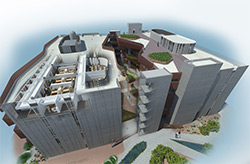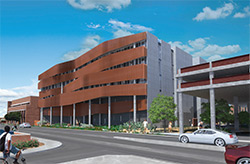
The environmental mission of the facility compels a fundamental response to our region, context, environment, sense of place and the special qualities of the Southwest and the Sonoran Desert. The project borrows from the iconic imagery of our region: striking landforms of canyon and mesa, the dramatic play of light, shade and shadow, the painted sky of sunsets, desert monsoons, highly adapted plants and animals.
The University units to be located in ENR2 are: Institute of the Environment, School of Geography & Development, and School of Natural Resources and the Environment. Space will also be allocated, on an interim basis, for a portion of the Department of Mathematics. The building will also include a 600 person undergrad auditorium for the Office of Academic Affairs and a coffee cafe.

ENR2 is a part of the University of Arizona's ongoing and concerted effort to promote interdisciplinary research that focuses on Earth Science and Environmental Programs. A key goal of this facility is to establish an atmosphere for collaboration of scientific and interdisciplinary research which creates great opportunities for graduate students across multiple disciplines.
Capitalizing on existing core disciplinary strengths will further establish the University of Arizona as a preeminent institution in basic earth sciences and environmental programs research. The location of the large high-tech auditorium in this project will provide undergraduate students the opportunity to experience a sustainable multi-discipline learning and research environment and participate in the outreach efforts developed by the occupants.
Sustainability Initiative
Scheduled for completion in June 2015, this building strives to go "beyond LEED" to explore innovative solutions to architecture in a desert environment. There are many sustainable components, both active and passive, with minimization of energy and water use being integral elements of the building design.
Passive Systems
Many of the important features of the building are passive systems that require little if any assistance from non-renewable energy sources. These passive systems include reconfiguring the building, which is responsive to each exposure, to include a central "canyon" courtyard that integrates exterior circulation and interaction space. Vertical metal fins and overhangs shade the building on the south facade and similar fins on the north address the less direct sun exposure. Minimal openings are located on the east and west where needed. The same shade elements are utilized within the canyon to create the effect of the curvilinear canyon wall. Substantial concrete walls, overhangs and structure provide both cool thermal mass and critical shade from the summer sun.
By creating exterior circulation and interaction spaces and tempering the exterior terraces with shade, planting and fans, the amount of conditioned space is reduced by approximately 30 percent. Landscape beds at each level will be irrigated with stored rainwater runoff, captured building condensate or reclaimed water and further temper the canyon to create exterior spaces that can be utilized year round.

Where possible, the building's structure is exposed. Concrete perimeter walls, ceilings and concrete superstructure reduce the need for additional materials altogether. Where additional materials are required, environmentally responsible materials are incorporated. In addition, as part of the building's flexibility, a raised access floor and large open office areas are used throughout the building in lieu of suspended ceiling tiles and partitions. The raised floor accentuates the flexibility of the building by placing the mechanical, electrical and communications within the floor space. This will facilitate future remodels making them less invasive and more cost efficient.
Finally, the building is engineered to accommodate a future research-based Photo Voltaic array on the roof along with other designated roof top research areas.
Active Systems
Active Systems that contribute to the sustainability of the facility create a work environment that will maximize comfort, putting the occupants in control of temperature and lighting. Natural lighting along with highly efficient light fixtures, light level and occupancy controls reduce electrical power consumption.
The HVAC system design is projected to realize on the order of a 25% reduction in annual energy budget when compared to a defined "baseline" system and involves an approach to indoor thermal control that has not been used on this scale at the University of Arizona Tucson campus.
A dedicated outdoor air system, combined with overhead induction coils known as "active" chilled beams provide the primary heating, ventilating and air conditioning function for perimeter office spaces on floors 2 through 5. This innovative system substantially reduces fan energy and provides a more accurate method of controlling fresh ventilation air.

Displacement ventilation systems are used in the open office and classroom areas. Benefits to this type of buoyancy-driven, low momentum system include high ventilation effectiveness, ability to extend airside economizer operation to an outside ambient temperature of 65 F, and low noise.
Reductions in water use are achieved by UA standard inclusion of waterless urinals, dual flush toilets and low flow/demand sensing faucets. But, in addition, as a part of the building water harvesting effort, a 52,000 gallon underground holding/filtration tank is located on the south side of the building.